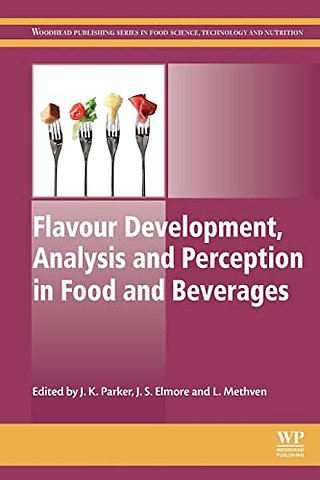<ul> <li>List of contributors</li> <li>Woodhead Publishing Series in Food Science, Technology and Nutrition</li> <li>Introduction</li> <li>Part One: Characterisation and analysis of aroma compounds<ul><li>1. Introduction to aroma compounds in foods<ul><li>Abstract</li> <li>1.1 Introduction to aroma</li> <li>1.2 Sensomics and some definitions</li> <li>1.3 Structure, aroma and occurrence of compounds containing carbon, hydrogen and oxygen</li> <li>1.4 Structure, aroma and occurrence of oxygen heterocycles and phenols</li> <li>1.5 Structure, aroma and occurrence of nitrogen compounds</li> <li>1.6 Structure, aroma and occurrence of sulfur compounds</li> <li>1.7 The future of flavour research</li> <li>1.8 Further reading</li></ul></li> <li>2. Extraction techniques for analysis of aroma compounds<ul><li>Abstract</li> <li>2.1 Introduction</li> <li>2.2 Choosing an appropriate method for aroma extraction</li> <li>2.3 Good practice</li> <li>2.4 Headspace SPME</li> <li>2.5 Solvent-assisted flavour evaporation</li> <li>2.6 Solid-phase extraction</li> <li>2.7 The future of aroma extraction</li></ul></li> <li>3. Aroma extract analysis<ul><li>Abstract</li> <li>3.1 Introduction</li> <li>3.2 Gas chromatography and mass spectrometry</li> <li>3.3 Quantification</li> <li>3.4 Gas chromatography–olfactometry</li> <li>3.5 Future trends in GC–MS</li></ul></li> <li>4. Analysis of taints and off-flavours<ul><li>Abstract</li> <li>4.1 Introduction</li> <li>4.2 The origins of taints and off-flavours in food</li> <li>4.3 Consumer perception and sensory evaluation</li> <li>4.4 Methods of analysis</li> <li>4.5 Examples of taints and the methods employed</li> <li>4.6 Future trends</li></ul></li> <li>5. Chemical sensors<ul><li>Abstract</li> <li>5.1 Introduction</li> <li>5.2 Beverage industry</li> <li>5.3 Perspectives for application of chemical sensors in the food and beverage industries</li> <li>5.4 Summary and conclusions</li></ul></li> <li>6. Aroma release<ul><li>Abstract</li> <li>6.1 Introduction</li> <li>6.2 Physicochemical properties of aroma compounds</li> <li>6.3 Equilibrium partitioning of flavour compounds</li> <li>6.4 Non-equilibrium partitioning of aroma compounds</li> <li>6.5 Aroma release during oral processing</li> <li>6.6 Future trends</li> <li>6.7 Sources of further information</li></ul></li></ul></li> <li>Part Two: Generation of aroma<ul><li>7. Biogenesis of aroma compounds: flavour formation in fruits and vegetables<ul><li>Abstract</li> <li>7.1 Introduction</li> <li>7.2 Biosynthesis of aroma compounds – general aspects</li> <li>7.3 Maturation and ripening processes</li> <li>7.4 Formation pathways for flavour compounds</li> <li>7.5 Conclusions</li></ul></li> <li>8. Thermal generation or aroma<ul><li>Abstract</li> <li>8.1 Introduction</li> <li>8.2 The Maillard reaction</li> <li>8.3 Lipid oxidation</li> <li>8.4 Other reactions</li> <li>8.5 Process flavours</li> <li>8.6 Summary and future work</li></ul></li> <li>9. The role of sulfur chemistry in thermal generation of aroma<ul><li>Abstract</li> <li>9.1 Introduction</li> <li>9.2 The Maillard reaction</li> <li>9.3 The Strecker degradation</li> <li>9.4 Thiamine degradation</li> <li>9.5 Allium species</li> <li>9.6 Roasted sesame seeds</li> <li>9.7 Conclusion</li></ul></li> <li>10. Predicting aroma formation with kinetic models<ul><li>Abstract</li> <li>10.1 Introduction</li> <li>10.2 Maillard reaction</li> <li>10.3 Kinetics and modelling</li> <li>10.4 Multiresponse modelling</li> <li>10.5 Some model studies on the Maillard reaction</li> <li>10.6 Kinetics and modelling of flavour compounds</li> <li>10.7 Future trends</li></ul></li> <li>11. Approaches to production of natural flavours<ul><li>Abstract</li> <li>11.1 Introduction</li> <li>11.2 Classical fermentation from a sugar source</li> <li>11.3 Microbial conversion of a natural precursor molecule</li> <li>11.4 Enzymatic conversion of a natural precursor molecule using a plant homogenate</li> <li>11.5 Fermentation from a sugar source using GMO</li> <li>11.6 Conclusion</li></ul></li> <li>12. Managing flavour changes during storage<ul><li>Abstract</li> <li>12.1 Introduction</li> <li>12.2 Lipid oxidation mechanism</li> <li>12.3 Impact of lipid oxidation on flavour</li> <li>12.4 Analysis of lipid oxidation</li> <li>12.5 Prevention of lipid oxidation</li> <li>12.6 Novel approaches for the prevention of oxidation</li> <li>12.7 Future trends</li> <li>12.8 Further reading</li></ul></li></ul></li> <li>Part Three: Perception of flavour<ul><li>13. Interaction of aroma compounds with food matrices<ul><li>Abstract</li> <li>13.1 Introduction</li> <li>13.2 Thermodynamic and kinetic properties of aroma compounds</li> <li>13.3 Physico-chemical interactions in simple systems</li> <li>13.4 Physico-chemical interactions in multiphasic systems</li> <li>13.5 Incidence of aroma–matrix interactions on aroma release and perception in cheeses</li> <li>13.6 Conclusion and future trends</li> <li>13.7 Sources of further information</li></ul></li> <li>14. Taste receptors<ul><li>Abstract</li> <li>14.1 Introduction</li> <li>14.2 Tastants</li> <li>14.3 Taste receptors: G protein-coupled receptors</li> <li>14.4 Taste receptors: ion channels</li> <li>14.5 Taste modulators</li> <li>14.6 Conclusion and future trends</li></ul></li> <li>15. Umami compounds and taste enhancers<ul><li>Abstract</li> <li>15.1 The molecular basis of umami taste perception</li> <li>15.2 Umami taste perception at the receptor level</li> <li>15.3 Identification of taste-active and taste-modulating compounds</li> <li>15.4 Molecular features of umami compounds and taste enhancers</li> <li>15.5 Natural occurrence of umami compounds and taste enhancers</li> <li>15.6 Summary and outlook: recent advances and trends in umami research</li></ul></li> <li>16. Techniques in sensory analysis of flavour<ul><li>Abstract</li> <li>16.1 Introduction to the fundamental types of sensory evaluation</li> <li>16.2 Analytical versus synthetic measurement</li> <li>16.3 Deciding on a sensory protocol</li> <li>16.4 Analytical sensory techniques and their relevance to flavour evaluation</li> <li>16.5 Individual differences in flavour perception</li> <li>16.6 Conclusion</li></ul></li> <li>17. Consumer perceptions of food and beverage flavour<ul><li>Abstract</li> <li>17.1 Introduction</li> <li>17.2 Multisensory integration and flavour perception</li> <li>17.3 Consumer preferences</li> <li>17.4 Individual differences in perception</li> <li>17.5 Consumer-oriented methods</li> <li>17.6 Conclusion</li></ul></li> <li>18. Physiological impacts of odour compounds<ul><li>Abstract</li> <li>Acknowledgement</li> <li>18.1 Introduction</li> <li>18.2 Immediate processes and effects</li> <li>18.3 Post-inhalation and post-ingestion processes</li> <li>18.4 Conclusions</li></ul></li></ul></li> <li>Index</li></ul>
